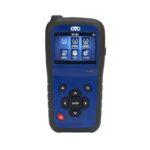In the realm of automotive diagnostics, the OBD-II trouble code P0237 signals a “Turbocharger/Supercharger Boost Sensor ‘A’ Circuit Low.” This generic powertrain code applies across various turbocharged vehicles from manufacturers like VW, Dodge, Mercedes, Chrysler, and Jeep, among others. Understanding this code is crucial for maintaining your vehicle’s performance and preventing potential damage. As an expert at autelfrance.com, I’m here to guide you through the intricacies of the P0237 code, helping you diagnose and address the issue effectively.
Decoding the P0237 Trouble Code
The heart of the P0237 code lies within the Manifold Absolute Pressure (MAP) sensor, responsible for monitoring boost pressure within your engine. The Powertrain Control Module (PCM) relies on this sensor to regulate and optimize engine performance, particularly in turbocharged systems.
Here’s a breakdown of how it works: the PCM sends a 5-volt reference signal to the MAP sensor. In turn, the MAP sensor transmits a variable voltage signal back to the PCM, reflecting the current boost pressure. Higher boost pressure results in a higher voltage signal, and conversely, lower pressure means lower voltage. The PCM uses this information, along with the boost control solenoid, to precisely manage the turbocharger’s boost output.
The P0237 code is triggered when the PCM detects an abnormally low voltage signal from the boost sensor “A,” indicating insufficient boost pressure. This occurs when the PCM commands high boost pressure via the boost control solenoid, but the MAP sensor reports a low pressure reading. Essentially, the system isn’t achieving the desired boost levels.
 Location of the MAP sensor on a vehicle engine for diagnosing P0237 code
Location of the MAP sensor on a vehicle engine for diagnosing P0237 code
Symptoms Associated with P0237
When the P0237 code arises, you may observe several symptoms affecting your vehicle’s performance:
- Check Engine Light Illumination: This is the most immediate indicator, alerting you to a potential issue within the engine management system.
- Reduced Engine Power: Insufficient boost pressure directly translates to diminished engine output, leading to noticeable sluggishness and lack of acceleration.
- Decreased Fuel Economy: The engine may compensate for the lack of boost by increasing fuel consumption, resulting in poorer mileage.
Ignoring the P0237 code can lead to more severe complications, including potential damage to the catalytic converter and turbocharger overboost situations in the long run. Prompt diagnosis and repair are therefore crucial.
Potential Causes of P0237
Several factors can contribute to the P0237 error code. Pinpointing the exact cause is essential for effective repair. Common culprits include:
- Faulty Boost Sensor “A” (MAP Sensor): A malfunctioning MAP sensor may provide inaccurate voltage readings, leading to the P0237 code.
- Turbocharger Issues: While less frequent, problems within the turbocharger itself, such as leaks or mechanical failures, can result in low boost pressure.
- PCM Malfunction: Although less common than other causes, a faulty PCM could misinterpret sensor signals or improperly control the boost system.
- Wiring Problems: This is often the most frequent cause. Damaged, corroded, or shorted wiring within the boost sensor circuit can disrupt signal transmission and trigger the P0237 code. Look for chafed or burnt wiring, especially near the hot turbocharger components.
 Visual inspection of wiring and connectors for P0237 diagnostic
Visual inspection of wiring and connectors for P0237 diagnostic
Diagnosing and Repairing P0237
Before diving into P0237 diagnostics, it’s vital to check for any other existing trouble codes. Address any other DTCs first, as they may indirectly cause the P0237 to set. Codes related to wastegate control or 5-volt reference circuits are particularly relevant and should be investigated initially.
Here’s a step-by-step diagnostic procedure to tackle the P0237 code:
- Preliminary Checks & Visual Inspection: Begin with a thorough visual inspection. Examine the wiring and connectors associated with the boost sensor “A” and boost control solenoid “A.” Look for signs of damage, corrosion, or loose connections. Disconnect and reconnect the connectors, carefully inspecting the terminals for spreading or damage. Apply silicone dielectric compound to all connections upon reassembly to improve contact and prevent future corrosion. Consult Technical Service Bulletins (TSBs) for your specific vehicle, as known issues and fixes may be documented.
- Voltage Testing (Key On Engine Off – KOEO): With the ignition key turned to the “ON” position and the engine off, use a Digital Volt Ohm Meter (DVOM) to backprobe the boost sensor reference wire at the sensor connector. Verify the presence of a 5-volt reference signal. Next, backprobe the boost sensor signal wire. It should read between 0.2 and 0.5 volts under normal atmospheric pressure. If these voltage readings are incorrect, suspect a faulty boost sensor.
- Dynamic Voltage Test (Engine Running): Keep the DVOM connected to the signal wire and start the engine. Using a handheld vacuum pump, apply vacuum to the turbocharger wastegate vacuum motor. As vacuum is applied, the voltage reading on the DVOM should increase. If the voltage increases as expected, the PCM is likely functioning correctly. If there is no voltage change, suspect a potential issue with the turbocharger or its vacuum control system. In cases where the voltage readings are consistently out of range despite a seemingly functional sensor and wiring, a PCM fault might be considered, although this is less common.
 Voltage testing of the MAP sensor signal wire for P0237 diagnosis
Voltage testing of the MAP sensor signal wire for P0237 diagnosis
Need Further Assistance with P0237?
Diagnosing OBD-II codes can sometimes be complex. If you require further guidance with the P0237 trouble code, don’t hesitate to post your question in our FREE car repair forums. Our community of experienced technicians and enthusiasts is ready to assist you.
Disclaimer: This information is for informational purposes only and should not be considered professional repair advice. We are not liable for any actions taken based on this information. Always consult a qualified technician for automotive repairs.

